The Behavior of Superabsorbent Polymers (SAPs) in Cement Mixtures with Glass Powders as Supplementary Cementitious Materials
Abstract
1. Introduction
2. Experimental Work
2.1. Materials
2.1.1. Superabsorbent Polymers (SAPs)
2.1.2. Binders
2.2. Experimental Investigations
2.2.1. Absorption
2.2.2. Flow Test
2.2.3. FTIR Analysis
2.2.4. Heat of Hydration
2.2.5. Desorption of SAPs in Pastes
2.2.6. Autogenous Shrinkage
3. Results and discussion
3.1. Absorption and Flow Results
3.2. FTIR Analysis
3.3. Isothermal, Setting Time and SEM Imaging
3.4. Desorption of SAPs in Pastes
3.5. Autogenous Shrinkage
4. Conclusions
- SAP absorption can be affected by addition of supplementary cementitious materials; generally, an increase in SAP absorption was observed when glass powders were used.
- The absorption behavior depended on the chemical compositions of SAPs; an increase in acrylic acid/acrylamide decreased absorption in SAPs.
- The results of isothermal calorimetry, setting time measurement and microscopy all indicated a delay in hydration and solid skeleton development at early age in the paste with G2 compared to the paste with G1.
- The SAPs exhibited a lower desorption rate in the paste with G2 than in the other two pastes; this can be attributed to a delay in relative humidity reduction and densification of microstructure, which are the driving factors for SAP desorption.
- The paste with G1 and G2 showed an increase in autogenous shrinkage, compared to the neat cement paste after approximately five days and 10 days, respectively. This is most likely due to the pozzolanic reaction, which results in finer pore structure.
- The addition of SAP-B reduced autogenous shrinkage in the pastes due to internal curing, and the reduction was more in neat cement paste than in the pastes with G1 and G2.
Author Contributions
Funding
Conflicts of Interest
References
- Mechtcherine, V.; Gorges, M.; Schroefl, C.; Assmann, A. Effect of internal curing by using superabsorbent polymers (SAP) on autogenous shrinkage and other properties of a high-performance fine-grained concrete: Results of a RILEM round-robin test. Mater. Struct. 2014, 47, 541–562. [Google Scholar] [CrossRef]
- Wang, K.; Jansen, D.C.; Shah, S.P.; Karr, A.F. Permeability study of cracked concrete. Cem. Concr. Res. 1997, 27, 381–393. [Google Scholar] [CrossRef]
- Baroghel-Bouny, V.; Mounanga, P.; Khelidj, A.; Loukili, A.; Rafai, N. Autogenous deformations of cement pastes: Part II. W/C effects, micro-macro correlations, and threshold values. Cem. Concr. Res. 2006, 36, 123–136. [Google Scholar] [CrossRef]
- Lura, P.; Jensen, O.M.; Weiss, J. Cracking in cement paste induced by autogenous shrinkage. Mater. Struct. 2009, 42, 1089–1099. [Google Scholar] [CrossRef]
- Lura, P.; Jensen, O.M.; van Breugel, K. Autogenous shrinkage in high-performance cement paste: An evaluation of basic mechanisms. Cem. Concr. Res. 2003, 33, 223–232. [Google Scholar] [CrossRef]
- Jensen, O.M.; Hansen, P.F. Water-entrained cement-based materials I. Principles and theoretical background. Cem. Concr. Res. 2001, 31, 647–654. [Google Scholar] [CrossRef]
- Snoeck, D.; Pel, L.; De Belie, N. Comparison of different techniques to study the nanostructure and the microstructure of cementitious materials with and withoutsuperabsorbent polymers. Constr. Build. Mater. 2019, 223, 244–253. [Google Scholar] [CrossRef]
- Soliman, A.M.; Nehdi, M.L. Effect of drying conditions on autogenous shrinkage in ultra-high performance concrete at early-age. Mater. Struct. 2011, 44, 879–899. [Google Scholar] [CrossRef]
- Cusson, D.; Hoogeveen, T. Internal curing of high-performance concrete with pre-soaked fine lightweight aggregate for prevention of autogenous shrinkage cracking. Cem. Concr. Res. 2008, 38, 757–765. [Google Scholar] [CrossRef]
- Şahmaran, M.; Lachemi, M.; Hossain, K.M.A.; Li, V.C. Internal curing of engineered cementitious composites for prevention of early age autogenous shrinkage cracking. Cem. Concr. Res. 2009, 39, 893–901. [Google Scholar] [CrossRef]
- Bentur, A.; Igarashi, S.; Kovler, K. Prevention of autogenous shrinkage in high-strength concrete by internal curing using wet lightweight aggregates. Cem. Concr. Res. 2001, 31, 1587–1591. [Google Scholar] [CrossRef]
- Mechtcherine, V.; Reinhardt, H.-W. Application of Super Absorbent Polymers (SAP) in Concrete Construction; Springer: Berlin, Germany, 2012. [Google Scholar]
- Beushausen, H.; Gillmer, M.; Alexander, M. The influence of superabsorbent polymers on strength and durability properties of blended cement mortars. Cem. Concr. Compos. 2014, 52, 73–80. [Google Scholar] [CrossRef]
- Hasholt, M.T.; Jensen, O.M. Chloride migration in concrete with superabsorbent polymers. Cem. Concr. Compos. 2015, 55, 290–297. [Google Scholar] [CrossRef]
- Mechtcherine, V.; Secrieru, E.; Schröfl, C. Effect of superabsorbent polymers (SAPs) on rheological properties of fresh cement-based mortars — Development of yield stress and plastic viscosity over time. Cem. Concr. Res. 2015, 67, 52–65. [Google Scholar] [CrossRef]
- Snoeck, D.; Schaubroeck, D.; Dubruel, P.; de Belie, N. Effect of high amounts of superabsorbent polymers and additional water on the workability, microstructure and strength of mortars with a water-to-cement ratio of 0.50. Constr. Build. Mater. 2014, 72, 148–157. [Google Scholar] [CrossRef]
- Montanari, L.; Suraneni, P.; Weiss, W.J. Accounting for Water Stored in Superabsorbent Polymers in Increasing the Degree of Hydration and Reducing the Shrinkage of Internally Cured Cementitious Mixtures. Adv. Civ. Eng. Mater. 2017, 6, 20170098. [Google Scholar] [CrossRef]
- de Sensale, G.R.; Goncalves, A.F. Effects of fine LWA and SAP as internal water curing agents. Int. J. Concr. Struct. Mater. 2014, 8, 229–238. [Google Scholar] [CrossRef]
- Jensen, O.M.; Hansen, P.F. Water-entrained cement-based materials II. Experimental observations. Cem. Concr. Res. 2002, 32, 973–978. [Google Scholar] [CrossRef]
- Lura, P.; Durand, F.; Loukili, A.; Kovler, K. Compressive strength of cement pastes and mortars with superabsorbent polymers. In Proceedings of the International RILEM Conference on Volume Changes of Hardening Concrete: Testing and Mitigation, Lyngby, Denmark, 20–23 August 2006; pp. 117–125. [Google Scholar]
- Igarashi, S.; Watanabe, A.; Jensen, O.M.; Lura, P.; Kovler, K. Experimental Study on Prevention of Autogenous Deformation by Internal Curing Using Super-Absorbent Polymer Particles; Jensen, O.M., Lura, P., Kovler, K., Eds.; RILEM Publications: Gabneus, France, 2006; pp. 77–86. [Google Scholar]
- Farzanian, K.; Ghahremaninezhad, A. Desorption of superabsorbent hydrogels with varied chemical compositions in cementitious materials. Mater. Struct. 2018, 51, 3. [Google Scholar] [CrossRef]
- Jensen, O.M. Use of Superabsorbent Polymers in Construction Materials. In Proceedings of the 1st International Conference on Microstructure Related Durability of Cementitious Composites, 2008; Sun, H.C.W., van Breugel, K., Miao, C., Ye, G., Eds.; RILEM Publications: Gabneus, France, 2008; pp. 757–764. [Google Scholar]
- Sikora, K.S.; Klemm, A.J. Effect of Superabsorbent Polymers on Workability and Hydration Process in Fly Ash Cementitious Composites. J. Mater. Civ. Eng. 2015, 27, 4014170. [Google Scholar] [CrossRef]
- Snoeck, D.; Velasco, L.F.; Mignon, A.; van Vlierberghe, S.; Dubruel, P.; Lodewyckx, P.; de Belie, N. The effects of superabsorbent polymers on the microstructure of cementitious materials studied by means of sorption experiments. Cem. Concr. Res. 2015, 77, 26–35. [Google Scholar] [CrossRef]
- de Meyst, L.; Mannekens, E.; Araújo, M.; Snoeck, D.; van Tittelboom, K.; van Vlierberghe, S.; de Belie, N. Parameter study of superabsorbent polymers (SAPs) for use in durable concrete structures. Materials 2019, 12, 1541. [Google Scholar] [CrossRef] [PubMed]
- Superabsorbent polymers—an additive to increase the freeze-thaw resistance of high strength concrete. In Advances in Construction Materials 2007; Springer: Berlin/Heidelberg, Germany, 2007.
- Snoeck, D.; Steuperaert, S.; van Tittelboom, K.; Dubruel, P.; de Belie, N. Visualization of water penetration in cementitious materials with superabsorbent polymers by means of neutron radiography. Cem. Concr. Res. 2012, 42, 1113–1121. [Google Scholar] [CrossRef]
- Lee, H.X.D.; Wong, H.S.; Buenfeld, N.R. Self-sealing of cracks in concrete using superabsorbent polymers. Cem. Concr. Res. 2016, 79, 194–208. [Google Scholar] [CrossRef]
- Mignon, A.; Graulus, G.J.; Martins, D.S.J.; de Belie, N.; Dubruel, P.; van Vlierberghe, S. pH-sensitive superabsorbent polymers: A potential candidate material for self-healing concrete. J. Mater. Sci. 2014, 50, 970–979. [Google Scholar] [CrossRef]
- Tan, Y.; Chen, H.; Wang, Z.; Xue, C.; He, R. Performances of Cement Mortar Incorporating Superabsorbent Polymer (SAP) Using Different Dosing Methods. Materials 2019, 12, 1619. [Google Scholar] [CrossRef]
- Woyciechowski, P.P.; Kalinowski, M. The influence of dosing method and material characteristics of superabsorbent polymers (SAP) on the effectiveness of the concrete internal curing. Materials 2018, 11, 1600. [Google Scholar] [CrossRef]
- Pourjavadi, A.; Fakoorpoor, S.M.; Hosseini, P.; Khaloo, A. Interactions between superabsorbent polymers and cement-based composites incorporating colloidal silica nanoparticles. Cem. Concr. Compos. 2013, 37, 196–204. [Google Scholar] [CrossRef]
- Farzanian, K.; Teixeira, K.P.; Rocha, I.P.; Carneiro, L.d.; Ghahremaninezhad, A. The mechanical strength, degree of hydration, and electrical resistivity of cement pastes modified with superabsorbent polymers. Constr. Build. Mater. 2016, 109, 156–165. [Google Scholar] [CrossRef]
- Wehbe, Y.; Ghahremaninezhad, A. Combined effect of shrinkage reducing admixtures (SRA) and superabsorbent polymers (SAP) on the autogenous shrinkage and properties of cementitious materials. Constr. Build. Mater. 2017, 138, 151–162. [Google Scholar] [CrossRef]
- Schröfl, C.; Mechtcherine, V.; Gorges, M. Relation between the molecular structure and the efficiency of superabsorbent polymers (SAP) as concrete admixture to mitigate autogenous shrinkage. Cem. Concr. Res. 2012, 42, 865–873. [Google Scholar] [CrossRef]
- Lothenbach, B.; Scrivener, K.; Hooton, R.D. Supplementary cementitious materials. Cem. Concr. Res. 2011, 41, 1244–1256. [Google Scholar] [CrossRef]
- Lumley, J.S. The ASR expansion of concrete prisms made from cements partially replaced by ground granulated blastfurnace slag. Constr. Build. Mater. 1993, 7, 95–99. [Google Scholar] [CrossRef]
- Hester, D.; McNally, C.; Richardson, M. A study of the influence of slag alkali level on the alkali–silica reactivity of slag concrete. Constr. Build. Mater. 2005, 19, 661–665. [Google Scholar] [CrossRef]
- Beglarigale, A.; Yazici, H. Mitigation of Detrimental Effects of Alkali-Silica Reaction in Cement-Based Composites by Combination of Steel Microfibers and Ground-Granulated Blast-Furnace Slag. J. Mater. Civ. Eng. 2014, 26, 4014091. [Google Scholar] [CrossRef]
- Gopinathan, S.; Anand, K.B. Properties of cement grout modified with ultra-fine slag. Front. Struct. Civ. Eng. 2018, 12, 58–66. [Google Scholar] [CrossRef]
- Dunstan, E. The Effect of Fly Ash on Concrete Alkali-Aggregate Reaction. Cem. Concr. Aggreg. 1981, 3, 101. [Google Scholar]
- Venkatanarayanan, H.K.; Rangaraju, P.R. Decoupling the effects of chemical composition and fineness of fly ash in mitigating alkali-silica reaction. Cem. Concr. Compos. 2013, 43, 54–68. [Google Scholar] [CrossRef]
- Harish, K.; Rangaraju, P. Effect of Blended Fly Ashes in Mitigating Alkali-Silica Reaction. Transp. Res. Rec. J. Transp. Res. Board. 2011, 2240, 80–88. [Google Scholar] [CrossRef]
- Shehata, M.H.; Thomas, M.D. The effect of fly ash composition on the expansion of concrete due to alkali–silica reaction. Cem. Concr. Res. 2000, 30, 1063–1072. [Google Scholar] [CrossRef]
- Pettersson, K. Effects of silica fume on alkali-silica expansion in mortar specimens. Cem. Concr. Res. 1992, 22, 15–22. [Google Scholar] [CrossRef]
- Boddy, A.M.; Hooton, R.D.; Thomas, M.D.A. The effect of the silica content of silica fume on its ability to control alkali–silica reaction. Cem. Concr. Res. 2003, 33, 1263–1268. [Google Scholar] [CrossRef]
- Mohamed, O.A.; Najm, O.F. Compressive strength and stability of sustainable self-consolidating concrete containing fly ash, silica fume, and GGBS. Front. Struct. Civ. Eng. 2017, 11, 406–411. [Google Scholar] [CrossRef]
- Kamali, M.; Ghahremaninezhad, A. Effect of glass powders on the mechanical and durability properties of cementitious materials. Constr. Build. Mater. 2015, 98, 407–416. [Google Scholar] [CrossRef]
- Flores, J.; Kamali, M.; Ghahremaninezhad, A. An Investigation into the Properties and Microstructure of Cement Mixtures Modified with Cellulose Nanocrystal. Materials 2017, 10, 1–16. [Google Scholar]
- Kamali, M.; Ghahremaninezhad, A. An investigation into the influence of superabsorbent polymers on the properties of glass powder modified cement pastes. Constr. Build. Mater. 2017, 149, 236–247. [Google Scholar] [CrossRef]
- Shao, Y.; Lefort, T.; Moras, S.; Rodriguez, D. Studies on concrete containing ground waste glass. Cem. Concr. Res. 2000, 30, 91–100. [Google Scholar] [CrossRef]
- Dyer, T.D.; Dhir, R.K. Chemical reactions of glass cullets used as cement component. J. Mater. Civ. Eng. 2001, 13, 412–417. [Google Scholar] [CrossRef]
- Wang, Z.; Song, C.S.J. Effect of glass powder on chloride ion transport and alkali-aggregate reaction expansion of lightweight aggregate concrete. J. Wuhan Univ. Technol. Sci. Ed. 2009, 24, 312–317. [Google Scholar] [CrossRef]
- Schwarz, N.; Cam, H.; Neithalath, N. Influence of a fine glass powder on the durability characteristics of concrete and its comparison to fly ash. Cem. Concr. Compos. 2008, 30, 486–496. [Google Scholar] [CrossRef]
- Nassar, R.-U.-D.; Soroushian, P. Green and durable mortar produced with milled waste glass. Mag. Concr. Res. 2012, 64, 605–615. [Google Scholar] [CrossRef]
- Nassar, R.-U.-D.; Soroushian, P. Strength and durability of recycled aggregate concrete containing milled glass as partial replacement for cement. Constr. Build. Mater. 2012, 29, 368–377. [Google Scholar] [CrossRef]
- Bazhuni, M.F.; Kamali, M.; Ghahremaninezhad, A. An investigation into the properties of ternary and binary cement pastes containing glass powder. Front. Struct. Civ. Eng. 2019, 13, 741–750. [Google Scholar] [CrossRef]
- Aquino, W.; Olek, D.L.J. The influence of metakaolin and silica fume on the chemistry of alkali–silica reaction products. Cem. Concr. Compos. 2001, 23, 485–493. [Google Scholar] [CrossRef]
- Ramlochan, T.; Thomas, M.; Gruber, K.A. The effect of metakaolin on alkali–silica reaction in concrete. Cem. Concr. Res. 2000, 30, 339–344. [Google Scholar] [CrossRef]
- Almeida, F.C.R.; Klemm, A.J. Efficiency of internal curing by superabsorbent polymers (SAP) in PC-GGBS mortars. Cem. Concr. Compos. 2018, 88, 41–51. [Google Scholar] [CrossRef]
- Snoeck, D.; Jensen, O.M.; de Belie, N. The influence of superabsorbent polymers on the autogenous shrinkage properties of cement pastes with supplementary cementitious materials. Cem. Concr. Res. 2015, 74, 59–67. [Google Scholar] [CrossRef]
- Siramanont, W.S.J.; Vichit-Vadakan, W. Behavior of Superabsorbent Polymers in Calcium- and Sodium-Rich Solutions. J. Mater. Civ. Eng. 2012, 24, 976–980. [Google Scholar]
- Schröfl, C.; Snoeck, D.; Mechtcherine, V. A review of characterisation methods for superabsorbent polymer (SAP) samples to be used in cement-based construction materials: Report of the RILEM TC 260-RSC. Mater. Struct. 2017, 50, 197. [Google Scholar] [CrossRef]
- Kang, S.H.; Moon, S.G.H.J. Absorption kinetics of superabsorbent polymers (SAP) in various cement-based solutions. Cem. Concr. Res. 2017, 97, 73–83. [Google Scholar] [CrossRef]
- Kang, S.H.; Moon, S.G.H.J. Importance of monovalent ions on water retention capacity of superabsorbent polymer in cement based solutions. Cem. Concr. Compos. 2018, 88, 64–72. [Google Scholar] [CrossRef]
- Krafcik, M.J.; Macke, N.D.; Erk, K.A. Improved Concrete Materials with Hydrogel-Based Internal Curing Agents. Gels 2017, 3, 46. [Google Scholar] [CrossRef] [PubMed]
- Zhu, Q.; Barney, C.W.; Erk, K.A. Effect of ionic crosslinking on the swelling and mechanical response of model superabsorbent polymer hydrogels for internally cured concrete. Mater. Struct. 2015, 48, 2261–2276. [Google Scholar] [CrossRef]
- Krafcik, M.J.; Erk, K.A. Characterization of superabsorbent poly ( sodium-acrylate acrylamide ) hydrogels and influence of chemical structure on internally cured mortar. Mater. Struct. 2016, 49, 4765–4778. [Google Scholar] [CrossRef]
- Esteves, L.P. Superabsorbent polymers: On their interaction with water and pore fluid. Cem. Concr. Compos. 2011, 33, 717–724. [Google Scholar] [CrossRef]
- Lee, H.X.D.; Wong, H.S.; Buenfeld, N.R. Effect of alkalinity and calcium concentration of pore solution on the swelling and ionic exchange of superabsorbent polymers in cement paste. Cem. Concr. Compos. 2018, 88, 150–164. [Google Scholar] [CrossRef]
- Pourjavadi, A.; Aghajani, V.; Ghasemzadeh, H. Synthesis, characterization and swelling behavior of chitosan-sucrose as a novel full-polysaccharide superabsorbent hydrogel. J. Appl. Polym. Sci. 2008, 109, 2648–2655. [Google Scholar] [CrossRef]
- Yang, F.W.J.; Wu, H.C.J.; Liang, X. Study on mechanism of desorption behavior of saturated superabsorbent polymers in concrete. ACI Mater. J. 2015, 112, 463–469. [Google Scholar]
- Mignon, A.; Snoeck, D.; Schaubroeck, D.; Luickx, N.; Dubruel, P.; van Vlierberghe, S.; de Belie, N. pH-responsive superabsorbent polymers: A pathway to self-healing of mortar. React. Funct. Polym. 2015, 93, 68–76. [Google Scholar] [CrossRef]
- Farzanian, K.; Ghahremaninezhad, A. The effect of the capillary forces on the desorption of hydrogels in contact with porous cementitious material. Mater. Struct. 2017, 50, 216. [Google Scholar] [CrossRef]
- Trtik, P.; Muench, B.; Weiss, W.J.; Herth, G.; Kaestner, A.; Lehmann, E.; Lura, P. Neutron tomography measurements of water release from superabsorbent polymers in cement paste. In Proceedings of the International Conference on Material Science and 64th RILEM Annual Week, Aachen, Germany, 6–10 September 2010; pp. 175–185. [Google Scholar]
- Toropovs, N.; Monte, F.L.; Wyrzykowski, M.; Weber, B.; Sahmenko, G.; Vontobel, P.; Felicetti, R.; Lura, P. Real-time measurements of temperature, pressure and moisture pro fi les in High-Performance Concrete exposed to high temperatures during neutron radiography imaging. Cem. Concr. Res. 2015, 68, 166–173. [Google Scholar] [CrossRef]
- Schroefl, C.; Mechtcherine, V.; Hovind, P.V.J.; Lehmann, E. Sorption kinetics of superabsorbent polymers (SAPs) in fresh Portland cement-based pastes visualized and quantified by neutron radiography and correlated to the progress of cement hydration. Cem. Concr. Res. 2015, 75, 1–13. [Google Scholar] [CrossRef]
- Nestle, N.; Kuhn, A.; Friedemann, K.; Horch, C.; Stallmach, F.; Herth, G. Water balance and pore structure development in cementitious materials in internal curing with modified superabsorbent polymer studied by NMR. Microporous Mesoporous Mater. 2009, 125, 51–57. [Google Scholar] [CrossRef]
- Snoeck, D.; Pel, L.; de Belie, N. The water kinetics of superabsorbent polymers during cement hydration and internal curing visualized and studied by NMR. Sci. Rep. 2017, 7, 1–14. [Google Scholar] [CrossRef]
- Farzanian, K.; Ghahremaninezhad, A. On the interaction between superabsorbent hydrogels and blended mixtures with supplementary cementitious materials. Adv. Civ. Eng. Mater. 2018, 7, 567–589. [Google Scholar] [CrossRef]
- Horkay, F.; Tasaki, I.; Basser, P.J. Osmotic Swelling of Polyacrylate Hydrogels in Physiological Salt Solutions. Biomacromolecules 2000, 1, 84–90. [Google Scholar] [CrossRef]
- Lin, D.C.; Dimitriadis, E.K.; Horkay, F. Robust strategies for automated AFM force curve analysis-II: Adhesion-influenced indentation of soft, elastic materials. J. Biomech. Eng. 2007, 129, 904–912. [Google Scholar] [CrossRef]
- Kamali, M.; Ghahremaninezhad, A. An investigation into the hydration and microstructure of cement pastes modified with glass powders. Constr. Build. Mater. 2016, 112, 915–924. [Google Scholar] [CrossRef]
- Monnig, S. Superabsorbing Additions in Concrete: Applications, Modeling and Comparison of Different Internal Water Sources; University of Stuttgart: Stuttgart, Germany, 2009. [Google Scholar]
- Olawuyi, B.J.; Boshoff, W.P. Influence of SAP content and curing age on air void distribution of high performance concrete using 3D volume analysis. Constr. Build. Mater. 2017, 135, 580–589. [Google Scholar] [CrossRef]
- Chavda, H.; Modhia, I.; Patel, R.; Patel, C. Preparation and characterization of superporous hydrogel based on different polymers. Int. J. Pharm. Investig. 2012, 2, 134. [Google Scholar] [CrossRef]
- Mahdavinia, G.R.; Pourjavadi, A.; Hosseinzadeh, H.; Zohuriaan, M.J. Modified chitosan 4. Superabsorbent hydrogels from poly(acrylic acid-co-acrylamide) grafted chitosan with salt- and pH-responsiveness properties. Eur. Polym. J. 2004, 40, 1399–1407. [Google Scholar] [CrossRef]
- Amir, R.M.; Anjum, F.M. Application of Fourier transform infrared (FTIR) spectroscopy for the identification of wheat varieties. J. Food Sci. Technol. 2013, 50, 1018–1023. [Google Scholar] [CrossRef] [PubMed]
- Farzanian, K.; Ghahremaninezhad, A. On the effect of chemical composition on the desorption of superabsorbent hydrogels in contact with a porous cementitious material. Gels 2018, 4, 70. [Google Scholar] [CrossRef] [PubMed]
- Wyrzykowski, M.; Lura, P. Reduction of Autogenous Shrinkage in OPC and BFSC Pastes with Internal Curing. In Proceedings of the XIII International Conference on Durability of Building Materials and Components, São Paulo, Brazil, 2–5 September 2014; Quattrone, M., John, V.M., Eds.; RILEM Publications: Gabneus, France, 2014; pp. 1010–1017. [Google Scholar]
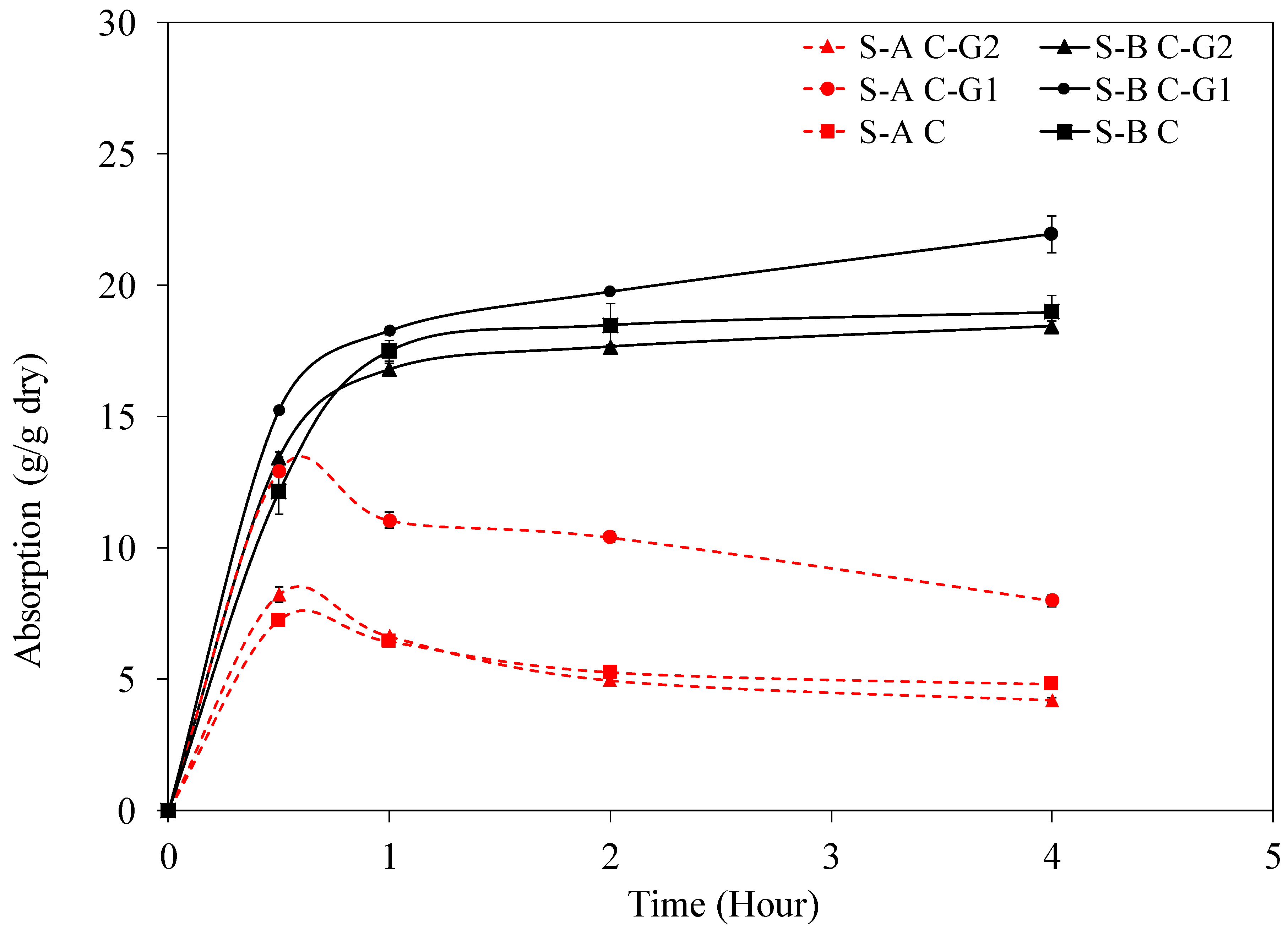
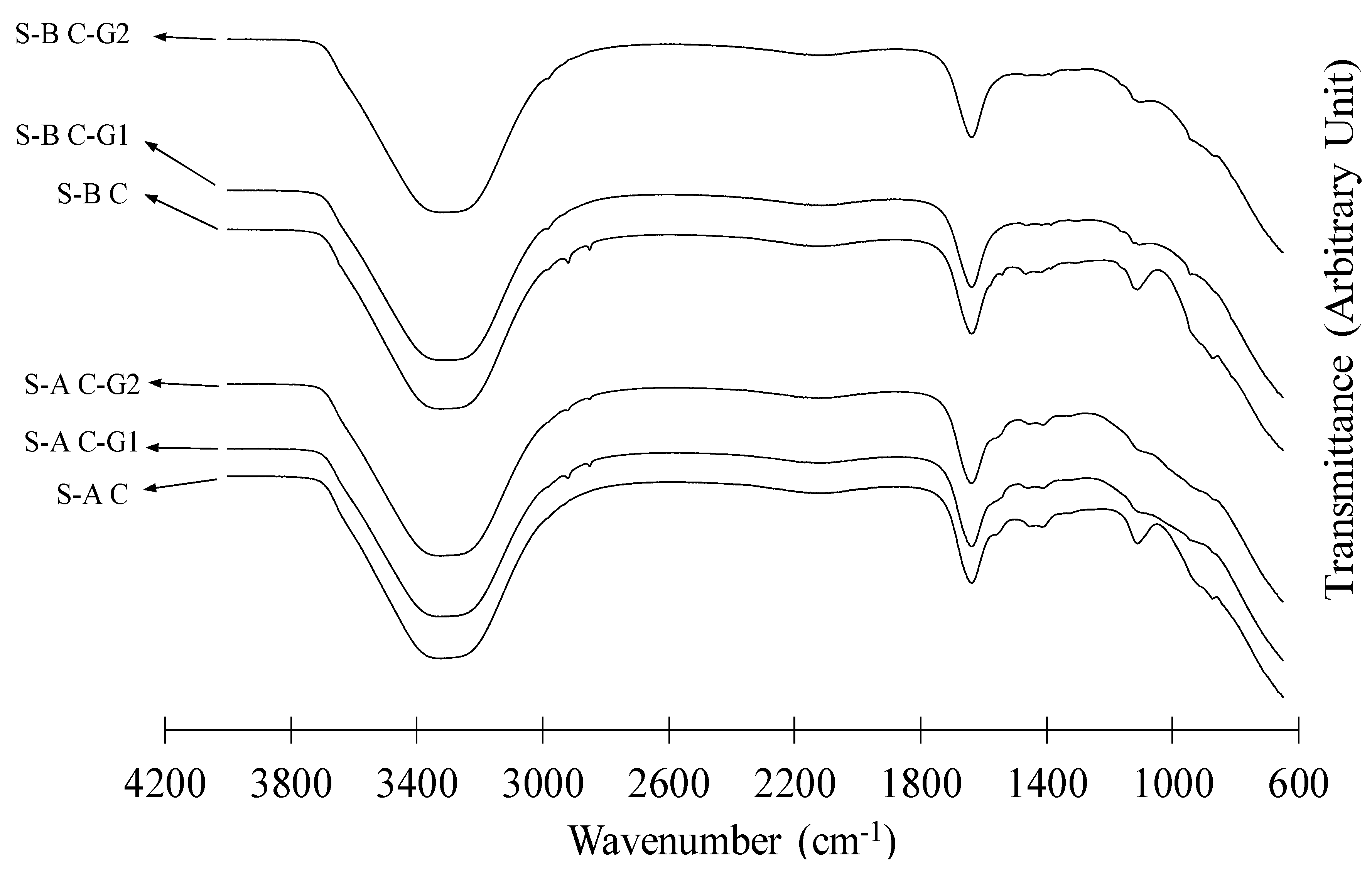
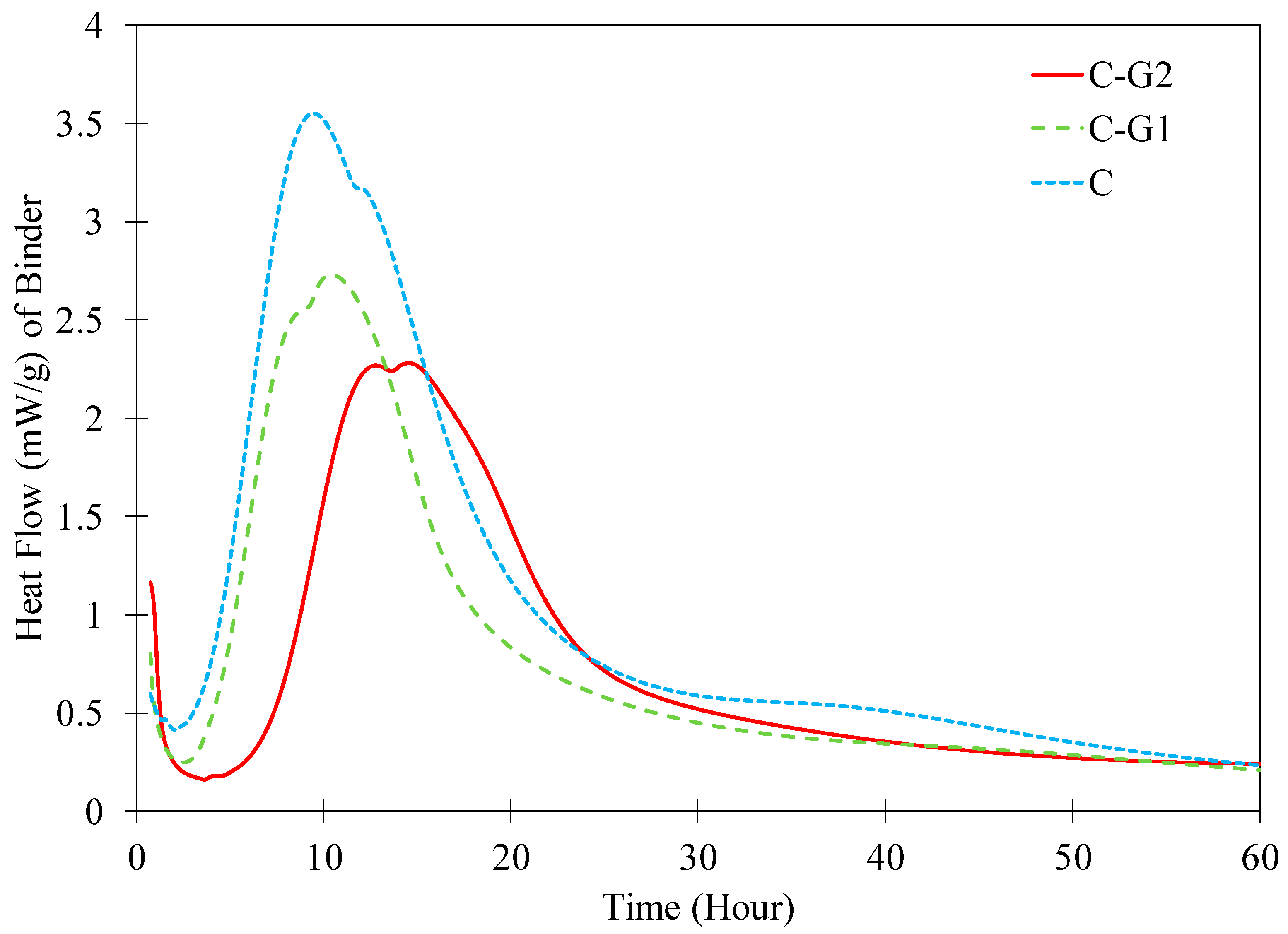
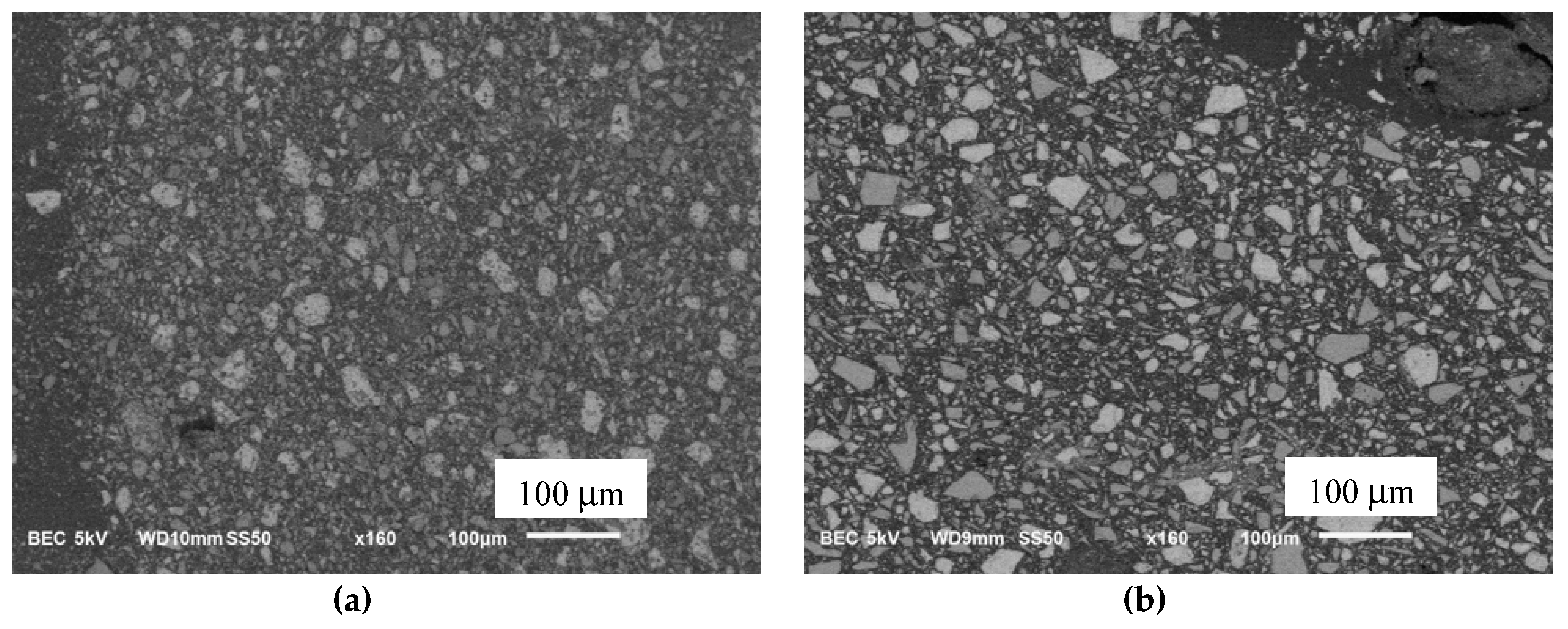
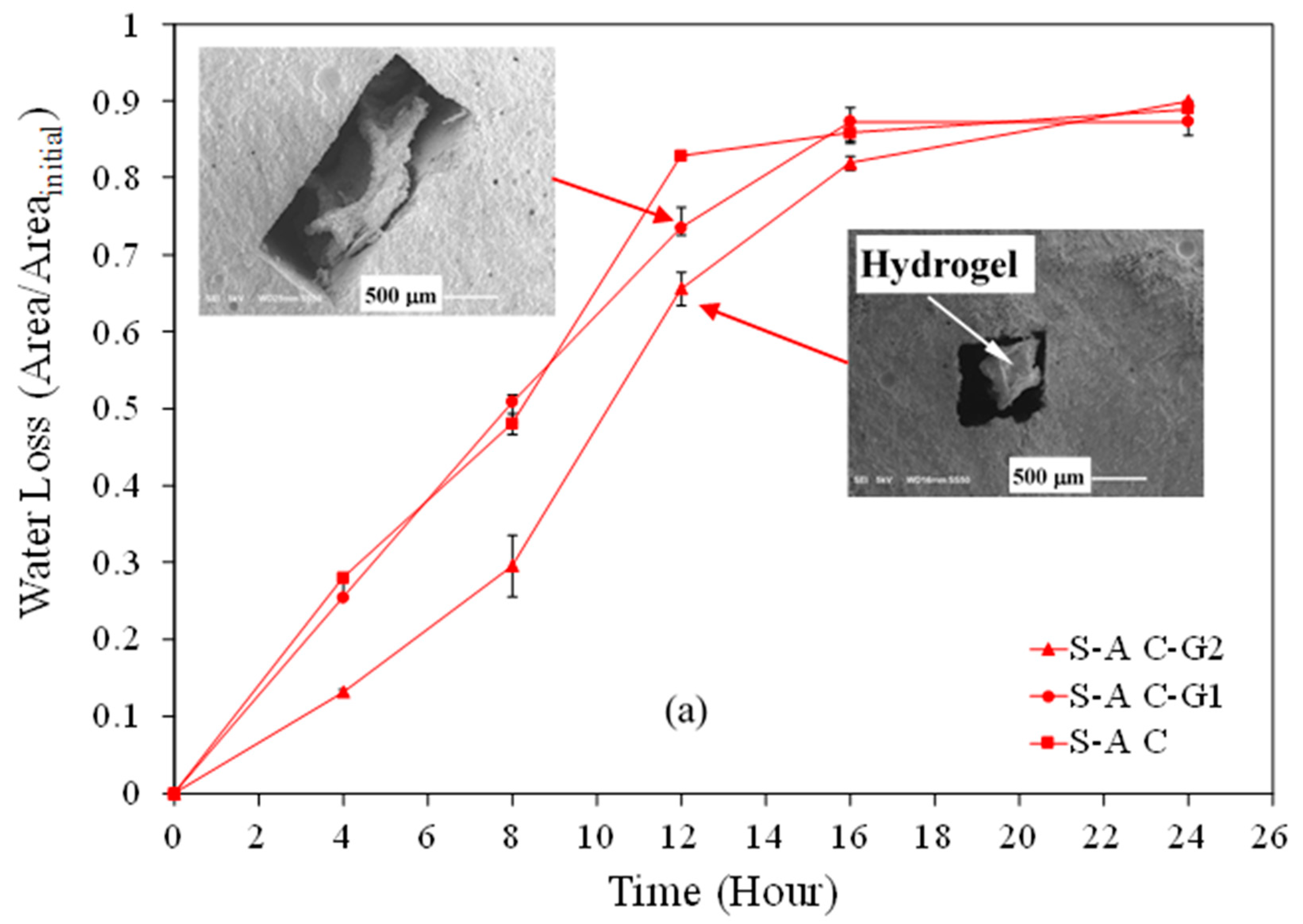
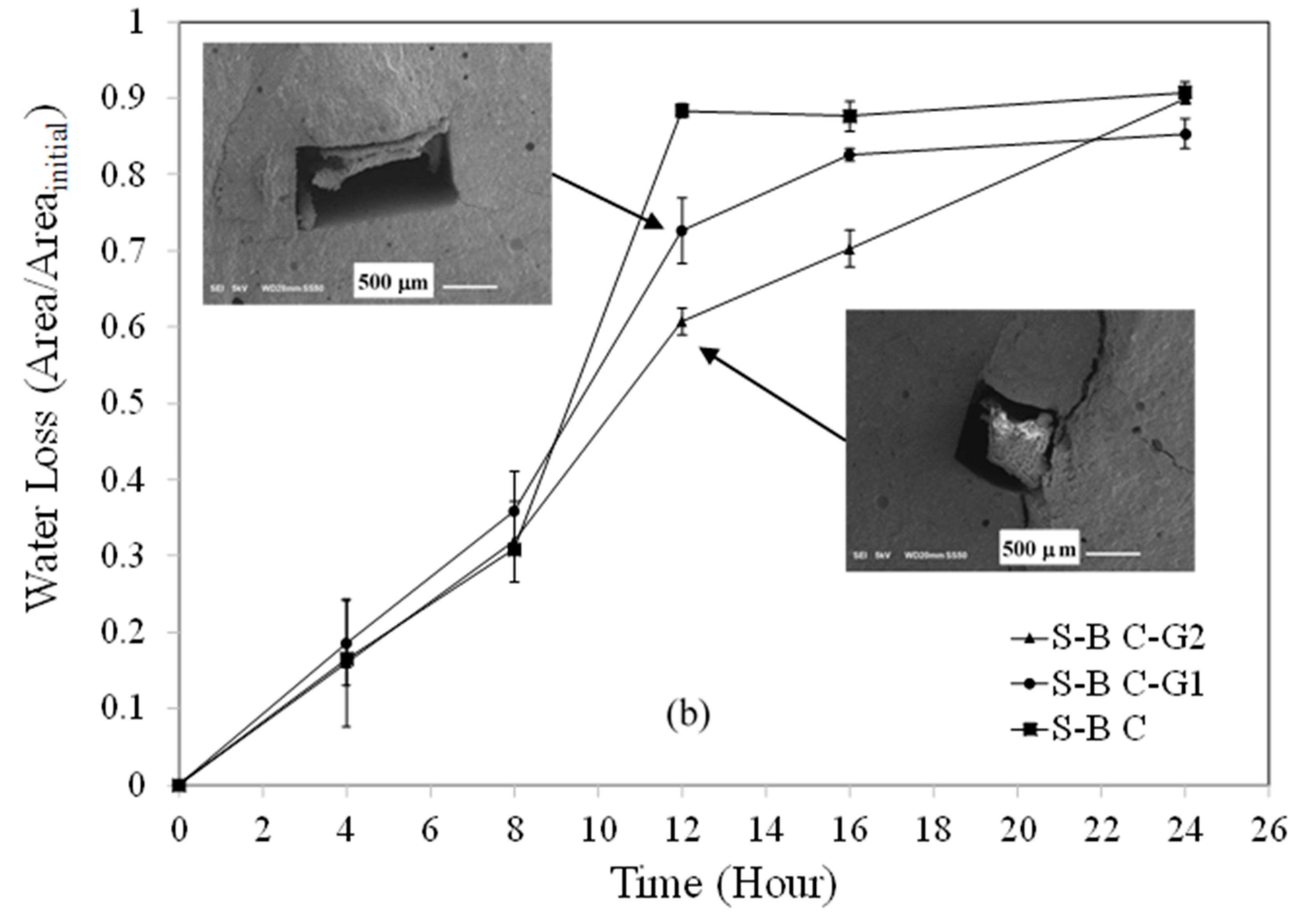
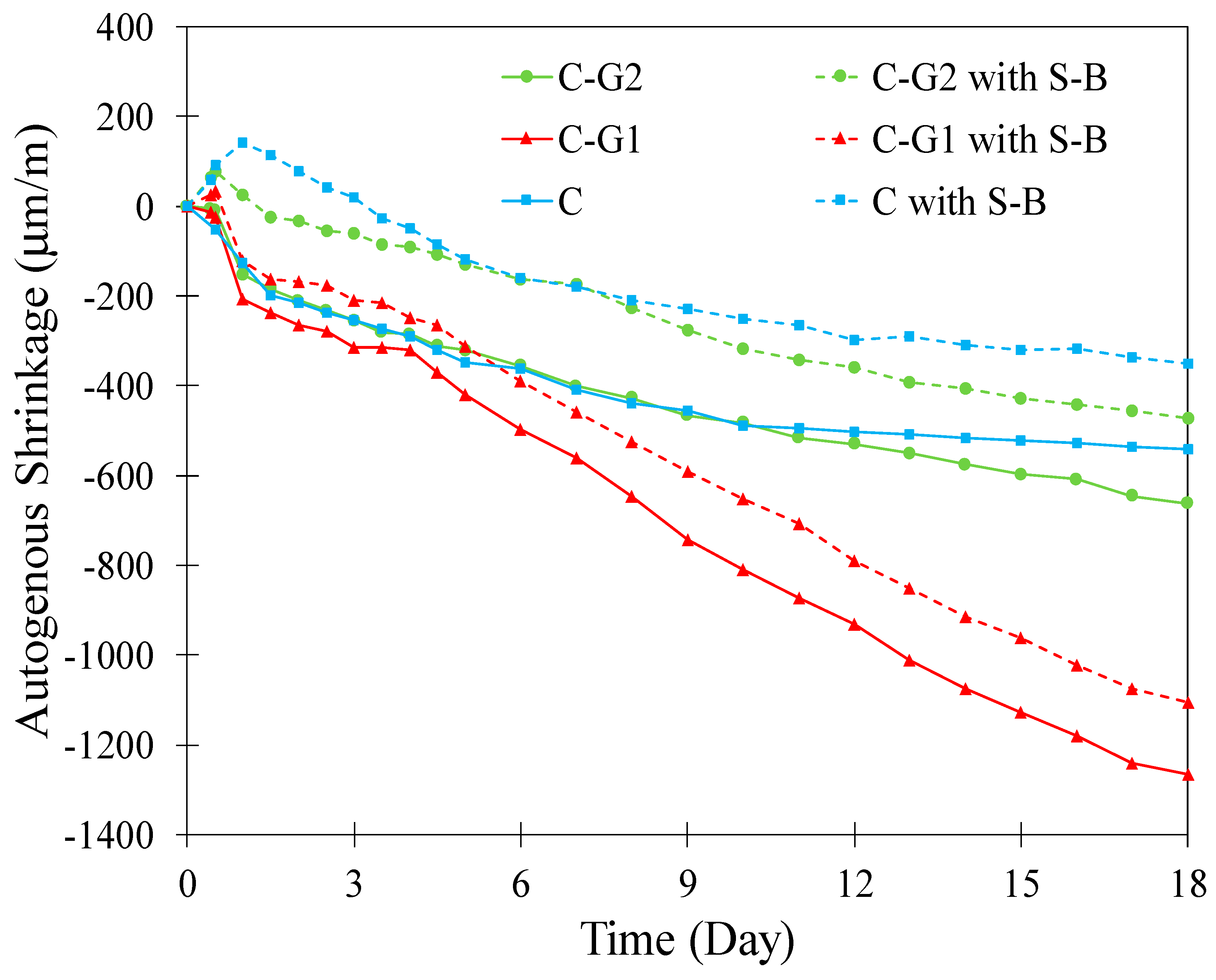
| SAP Designation | Acrylamide (g) | Acrylic Acid (g) | MBA (Cross-linker) (g) | Ammonium Persulfate (g) | Sodium Hydroxide (g) | Distilled Water (g) |
|---|---|---|---|---|---|---|
| S-A | 5 | 5 | 0.025 | 0.064 | 0.675 | 50 |
| S-B | 9 | 1 | 0.025 | 0.064 | 0.135 | 50 |
| Composition (%) | Cement | G1 | G2 |
|---|---|---|---|
| SiO2 | 20.6 | 63.3 | 57.5 |
| Al2O3 | 4.8 | 6.4 | 12.7 |
| Fe2O3 | 3.5 | 0.31 | 0.06 |
| CaO | 64 | 17.1 | 22.7 |
| MgO | 0.9 | 4.5 | 3.6 |
| Na2O | 0.1 | 6.1 | 0.62 |
| K2O | 0.3 | 0.07 | 0.06 |
| SO3 | 3.4 | 0.19 | 0.22 |
| Paste Designation | Water/Binder (Paste) | Water/Binder (Slurry) | Cement Replacement | Superplasticizer Percentage (per Binder Mass) |
|---|---|---|---|---|
| C | 0.3 | 2 | 0% | 0.5% |
| C-G1 | 0.3 | 2 | 40% | 0.5% |
| C-G2 | 0.3 | 2 | 40% | 0.5% |
| Paste Designation | S-A (% per Binder Mass) | S-B (% per Binder Mass) | Flow Value (cm) |
|---|---|---|---|
| C | 0.42 | 0.17 | 20 |
| C-G1 | 0.13 | 0.05 | 20 |
| C-G2 | 0.33 | 0.08 | 20 |
| Paste Designation | Initial Setting Time (min) | Final Setting Time (min) |
|---|---|---|
| C | 345 | 495 |
| C-G1 | 200 | 495 |
| C-G2 | 525 | 705 |
© 2019 by the authors. Licensee MDPI, Basel, Switzerland. This article is an open access article distributed under the terms and conditions of the Creative Commons Attribution (CC BY) license (http://creativecommons.org/licenses/by/4.0/).
Share and Cite
Farzanian, K.; Vafaei, B.; Ghahremaninezhad, A. The Behavior of Superabsorbent Polymers (SAPs) in Cement Mixtures with Glass Powders as Supplementary Cementitious Materials. Materials 2019, 12, 3597. https://doi.org/10.3390/ma12213597
Farzanian K, Vafaei B, Ghahremaninezhad A. The Behavior of Superabsorbent Polymers (SAPs) in Cement Mixtures with Glass Powders as Supplementary Cementitious Materials. Materials. 2019; 12(21):3597. https://doi.org/10.3390/ma12213597
Chicago/Turabian StyleFarzanian, Khashayar, Babak Vafaei, and Ali Ghahremaninezhad. 2019. "The Behavior of Superabsorbent Polymers (SAPs) in Cement Mixtures with Glass Powders as Supplementary Cementitious Materials" Materials 12, no. 21: 3597. https://doi.org/10.3390/ma12213597
APA StyleFarzanian, K., Vafaei, B., & Ghahremaninezhad, A. (2019). The Behavior of Superabsorbent Polymers (SAPs) in Cement Mixtures with Glass Powders as Supplementary Cementitious Materials. Materials, 12(21), 3597. https://doi.org/10.3390/ma12213597







